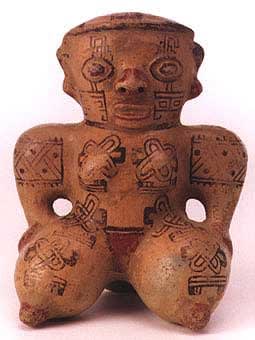Galo Polychrome Female Figurine, 500 CE - 800 CE
Terracotta
5.5 x 9.5
PF.3213
Galo Polychrome figures provide a wealth of ethnographic detail because of their realistic style. Coiffures, clothing, and careful body painting or tattooing are all clearly shown. Patterns acceptable for female...
Galo Polychrome figures provide a wealth of ethnographic detail because of their realistic style. Coiffures, clothing, and careful body painting or tattooing are all clearly shown. Patterns acceptable for female body decoration were probably different from those for males, for whom mythologically important animal traits predominate. Galo effigies are almost always female. The mirror-bright burnished surface is technically unsurpassed by any Pre-Columbian pottery, and the angular geometric patterns of reddish-orange, black and cream are impressively vivid. The guilloche (an ornament formed by two or more intertwining bands or intersecting lines) and woven-mat patterns are indicative of high rank. They represent the finest ceramics of the great tradition of polychrome pottery in Guanancaste- Nicoya.
Humans invented symbols, among the first of which was woman. . . the promise of life;
fertility with a human face. This voluptuous and sensitive Galo Polychrome female looks as though she knows her place in the world: at the very top! And she has every right to feel this way, she represents life. It's difficult to imagine what the elaborate ornaments on her over-exaggerated limbs and body precisely mean. We can only suggest that they are complex cosmogonies and rituals that will forever remain impenetrable. She looks right through us as if she can see the source of creation for humankind. The answer to the question which has been contemplated since the beginning of time seems to be held for eternity on her parted lips.
Humans invented symbols, among the first of which was woman. . . the promise of life;
fertility with a human face. This voluptuous and sensitive Galo Polychrome female looks as though she knows her place in the world: at the very top! And she has every right to feel this way, she represents life. It's difficult to imagine what the elaborate ornaments on her over-exaggerated limbs and body precisely mean. We can only suggest that they are complex cosmogonies and rituals that will forever remain impenetrable. She looks right through us as if she can see the source of creation for humankind. The answer to the question which has been contemplated since the beginning of time seems to be held for eternity on her parted lips.



